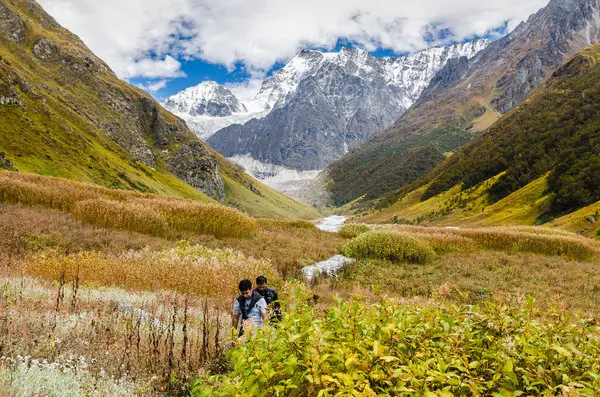Mountain valleys, those stunning depressions nestled between towering peaks, are some of the most breathtaking landscapes on Earth. They are formed through geological processes like glaciation, erosion, and tectonic activity, each contributing to the unique beauty and ecological significance of these natural wonders. As explored in various New York Times articles, mountain valleys offer a deep dive into both the splendor and the scientific intrigue of our planet’s topography.
Formation and Characteristics
Mountain valleys are primarily shaped by the forces of nature. Glacial valleys, for example, are carved by the immense power of moving ice. As glaciers advance and retreat, they sculpt the landscape into characteristic U-shaped valleys. In contrast, river valleys are typically V-shaped, formed by the relentless erosion of flowing water over long periods. Tectonic activity also plays a significant role; the collision of tectonic plates can create fault-block valleys or uplift valleys, adding to the diversity of valley forms.
One of the most iconic examples of a mountain valley is the Yosemite Valley in California’s Sierra Nevada. Carved by glacial action, Yosemite Valley’s sheer granite walls and cascading waterfalls make it a quintessential representation of glacial valley grandeur. The Matterhorn Glacier in the Swiss Alps also showcases the dramatic impact of glaciation on valley landscapes, with its deep, U-shaped troughs and rugged terrain.
Ecological Significance
Mountain valleys are not just visually stunning; they are ecologically vital. These valleys often harbor unique ecosystems and biodiversity. The varied elevation and climate conditions within a valley create diverse habitats for numerous plant and animal species. For instance, the rich soil and ample water supply in valley floors support lush vegetation, which in turn supports a diverse range of wildlife.
In the Great Smoky Mountains, the Cades Cove Valley is renowned for its rich biodiversity. This valley’s diverse plant life, including oak-hickory forests and wildflowers, supports a variety of animals such as deer, black bears, and a multitude of bird species. The Valley of Flowers in India’s Himalayas is another example, with its spectacular array of alpine flowers providing crucial resources for pollinators and other wildlife.
Cultural and Recreational Aspects
Throughout history, mountain valleys have been significant to human cultures. They often serve as hubs of settlement, agriculture, and commerce due to their relatively flat and fertile land compared to the surrounding rugged terrain. The scenic beauty of these valleys also makes them popular destinations for tourism and recreation.
For instance, the Rhône Valley in France is renowned not only for its picturesque landscapes but also for its wine production, which has been a staple of the region’s economy and culture for centuries. Similarly, the Kathmandu Valley in Nepal has been a cultural and economic center for millennia, with its rich history reflected in the valley’s temples and heritage sites.
Outdoor enthusiasts flock to mountain valleys for hiking, climbing, and other recreational activities. The Swiss Alps, with their stunning valleys like Lauterbrunnen, are a prime destination for hikers and mountaineers. In the United States, the Appalachian Trail passes through numerous mountain valleys, offering hikers a chance to experience the tranquil beauty of these landscapes.
Environmental Challenges
Despite their beauty, mountain valleys face environmental challenges. Climate change, for instance, is altering glacial patterns and affecting water sources. In some valleys, glaciers are retreating at alarming rates, which can lead to reduced water flow in rivers and affect local ecosystems.
Additionally, human activities such as deforestation, agriculture, and tourism can impact the delicate balance of these environments. Protecting mountain valleys involves sustainable practices, conservation efforts, and increased awareness of their ecological importance.
Conclusion
Mountain valleys are a testament to the dynamic forces of nature and the intricate beauty of our planet. From their geological formation to their ecological and cultural significance, these valleys offer a rich tapestry of natural splendor and human connection. As we continue to explore and enjoy these landscapes, it is essential to foster a deep respect for their environmental importance and strive for their preservation for future generations.
FAQs on Mountain Valleys
1. What is a mountain valley?
A mountain valley is a low-lying area situated between higher elevations such as mountain peaks or ridges. It is typically formed through geological processes such as glaciation, erosion, or tectonic activity. The valley’s shape can vary depending on its formation: U-shaped valleys are often carved by glaciers, while V-shaped valleys are created by the erosive action of rivers.
2. How are mountain valleys formed?
Mountain valleys are formed through several processes:
- Glacial Erosion: Glaciers carve out U-shaped valleys as they advance and retreat, scraping away rock and sediment.
- River Erosion: Rivers cut through rock over time, creating V-shaped valleys with their flowing waters.
- Tectonic Activity: Movements of the Earth’s crust, such as faulting or folding, can create valleys between rising mountain ranges.
3. What types of mountain valleys are there?
There are several types of mountain valleys:
- Glacial Valleys: Characterized by their U-shaped cross-sections, formed by glacial activity.
- River Valleys: Typically V-shaped, formed by the continuous erosion of rivers.
- Tectonic Valleys: Created by tectonic forces, such as faulting or folding, often featuring rugged terrain.
4. Why are mountain valleys important ecologically?
Mountain valleys are ecologically significant because they provide diverse habitats for many plant and animal species. Their varied elevations and microclimates support different ecosystems, including forests, meadows, and wetlands. Valleys often serve as crucial wildlife corridors and support biodiversity by offering resources such as water and shelter.
5. What are some famous mountain valleys around the world?
Notable mountain valleys include:
- Yosemite Valley in California, USA, renowned for its stunning granite cliffs and waterfalls.
- The Rhône Valley in France, known for its vineyards and historical significance.
- The Kathmandu Valley in Nepal, rich in cultural heritage and history.
- Cades Cove in the Great Smoky Mountains, USA, famous for its wildlife and historical structures.
- Valley of Flowers in India, celebrated for its diverse alpine flora.

